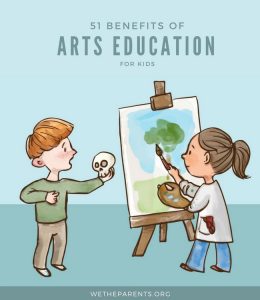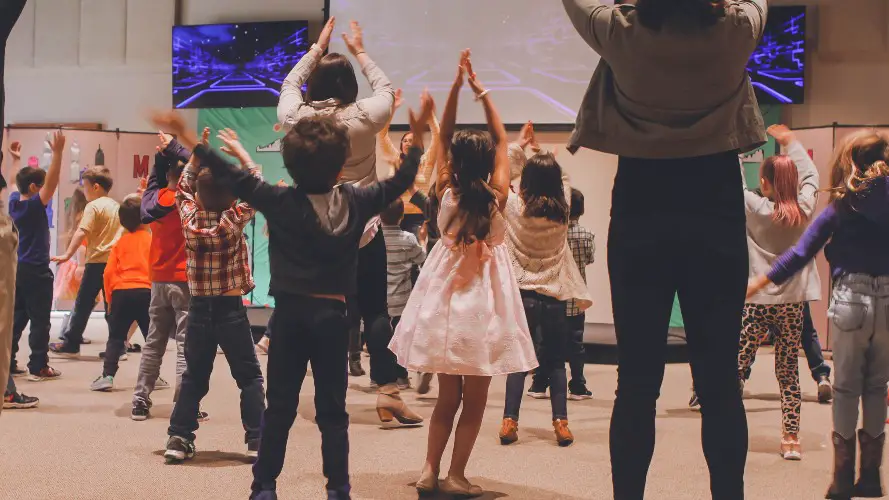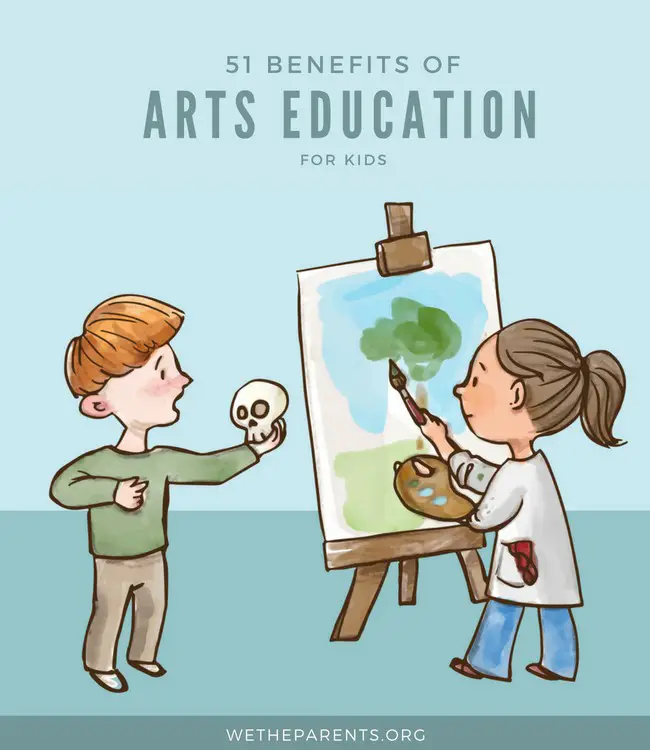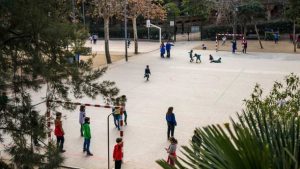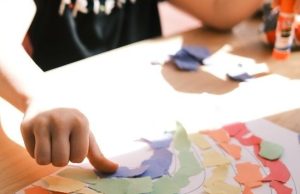For many schools, arts education is teetering on a precipice.
Overwhelmingly, parents feel that the arts play a vital role in their children’s education. And yet, at the very same time, schools are under pressure to funnel their dwindling educational resources into a purely “academic” curriculum, focusing on math, literacy, and science.
It’s time to take a stand.
For one thing, learning arts improves academic achievement, and there are plenty of studies that show this. (Yes, some of these lack scientific rigor but this only highlights the need to invest more in robust research.)
More importantly, though, kids immersed in arts get the opportunity to experience the world, and themselves, in a different way; one that cultivates cognitive abilities, nurtures positive character traits, and fosters critical thinking.
If you’re still not sure, here is a list (backed up by studies) of 51 ways that arts education rewards children.
In this article:
The 51 Benefits [Infographic]

The rewards of arts education for children: Examining the evidence
1. Builds confidence
Schoolage children can often grapple with their confidence. As they study art, the chance to present their work or to perform for their peers and community often presents itself. With this opportunity to shine, they are improving their self-image.
Performance arts are especially good at pulling kids out of their comfort zone and giving them a chance to become comfortable in front of larger crowds.1Phillips, L. (2012). The top 10 skills children learn from the arts. Washington Post.
washingtonpost.com
2. Raises self-esteem
Kids often base their self-worth on external factors. How do their peers regard them? How do they compare to the models on the covers of magazines?
Participation in the arts is something that comes from the inside; no one but the child can dictate the final product, and independence is encouraged.27 Most Effective Self-Esteem Tools and Activities
positivepsychology.com
3. Teaches perseverance
It can be easy for kids to get bogged down in the notion that lessons are over after the big test, a class is completed upon a final grade, and they only need to understand a topic well enough to do that last paper.
Studying art demonstrates, with tangible results, that learning something from the ground up is essential, and remembering the basics will only improve on future performances.
4. Ignites inner motivation
It can be hard to tell a child that their understanding of ‘To Kill A Mocking Bird’ will pay off when they are in college. While future success can certainly be enticing, kids first need to know what progress looks like.
As children study an art form, be it music, drawing, or any other medium, they are seeing the results of their perseverance. That hard work can have both short-term and long-term benefits, is something they can carry with them into other academic areas.
5. Benefits emotional development
We all strive to teach our children how to be empathetic, compassionate, and expressive. However, we can be limited by our own experiences and life circumstances.
Art has no such hindrances. By encouraging its education, your child will be exposed to lands and lives of which they otherwise would have known nothing, which will likely foster their empathizing skills.
6. Develops a broader, more nuanced understanding of the world
As your child develops empathy for people in worlds unknown, they will also begin to see how different individuals react to difficult situations, thus forming a more accurate perception of the world.
If this seems like a tall order for an arts-based class, remember that art doesn’t come solely from the rich or academically gifted. As the saying goes, the whole is greater than the sum of its parts, so you should welcome the myriad of voices that your child can hear through art.
7. Gives rise to introspection and personal reflection
The formative years of childhood are spent learning not only about our world, but also learning about ourselves. Unfortunately, a solely academic-based education is not necessarily conducive to a lot of self-examination.
By including arts education in school, children can find a healthy outlet for their frustrations, joys, sadness, and victories, which is something that they otherwise would not have had.
8. Encourages exploration and experimentation
One of the beauties of arts education is the constant trial and error your child experiences. Whether they are learning about what color schemes they like the best on a canvas or how to tweak their solo in a choral piece, there is no right or wrong answer.
Art studies are unique in the level of freedom they provide to growing minds.
9. Nurtures self-expression
Children spend years figuring out the kind of person they want to become. It can often seem like an uphill battle as they try to balance social expectations and rules with their internal desires.
Encouraging their artistic expression is a way for them to discover and show their true colors, without constraints or judgment.3RISD CE Logo
ce.risd.edu
10. Trains healthy risk-taking
We want our children to be unafraid taking little risks on their journey through life. Academic classes, such as math, aren’t designed for this type of behavior, yet it is necessary for development.4St, M. E., Con, A., & Con, A. (2019). Fine Arts. Economics.
www.pbs.org
Participation in the arts can be a means of exploration that includes creative risks, none of which will actually harm your kids. Afterall, trying to draw a bird but creating something that looks more like a cloud isn’t going to end in a hospital visit.
11. Develops cognitive ability
The human brain goes through a significant amount of development throughout the childhood years. Exposing our young to pursuits of all kinds can have long-lasting, positive effects, and art is no exception.5Shonkoff, J., Levitt, P., Boyce, W. T., Fox, N. A., Gunnar, M., Mayes, L. C., … & Rojnik, A. J. J. (2009). In brief: The science of early childhood development. Center on the Developing Child at Harvard University. Retrieved from: http://developingchild. harvard.edu/index. php/resources/multimedia/videos/inbrief_series.
developingchild.harvard.edu
In fact, there is a correlation between a child’s ability to interpret artwork and their ability to understand scientific images.
12. Increases creativity
Virtually everything that has been invented to make our lives easier has come from the mind of a creative individual. It stands to reason that creativity is a cornerstone of success and should be encouraged in our children.
Participation in the arts can promote this kind of brain-growth. For example, students who play instruments exhibit several creative benefits, as do dancers.6theconversation.com|7Ruppert, S. S. (2006). Critical evidence: How the arts benefit student achievement. National Assembly of State Arts Agencies. 1029 Vermont Avenue NW, Washington, DC 20005.
files.eric.ed.gov
13. Improves decision making
We want to send our children into the world as young adults who are perfectly capable of weighing the benefits and drawbacks when making life choices. To do this, they need to have developed critical thinking skills.
Studying and participating in the arts is shown to encourage and improve these skills.8Encouraging art in a child develops an adult creative thinker
nydailynews.com
14. Raises IQ score
The beauty of arts education is that there is so much crossover to traditional academics and intellectual performance.
While current studies are ongoing, there is definitive proof that participation in music programs do show improved IQ scores.9Art for Art’s Sake Executive Summary.pdf
www.oecd.org
15. Helps visual, spatial, and temporal reasoning
Sculpting, drawing, and even bead threading are all linked with advancing a child’s ability in these areas, as does music participation.10The Importance of Art in Child Development
www.pbs.org
While there is evidence that taking part in dance classes can improve a child’s visual-spatial reasoning, there is not yet enough conclusive evidence.11Art for Art’s Sake Executive Summary.pdf
www.oecd.org
16. Boosts concentration
How many times have we wished our kids could improve their focusing skills? By insisting that arts continue to be a presence in our schools, we are likely teaching our children essential concentration skills that they will carry with them for life.12Bowen, D. H., Greene, J. P., & Kisida, B. (2014). Learning to think critically: A visual art experiment. Educational Researcher, 43(1), 37-44.
journals.sagepub.com
17. Builds up critical thinking
There is a notable correlation between an education that involves the arts and other useful skills. Students from one study exhibited an enhanced ability to think critically after participating in an art program, with those from disadvantaged backgrounds showing the largest increase in such skills.13Bowen, D. H., Greene, J. P., & Kisida, B. (2014). Learning to think critically: A visual art experiment. Educational Researcher, 43(1), 37-44.
journals.sagepub.com
18. Expands verbal skills
The ability to express oneself with their words will dictate how far they get in life. Science currently suggests that arts education will improve verbal skills, especially when theater is the art being studied.14Art for Art’s Sake Executive Summary.pdf
oecd.org
19. Improves word decoding
As important as being adept at expressing oneself is the ability to understand what others are saying. The study of music can enhance these skills in our children, making it a vital area of education.15Art for Art’s Sake Executive Summary.pdf
oecd.org
20. Encourages closer observation
As kids learn to study, understand, and produce art of any kind, their minds are working hard to pick up the nuances of the trade. They are then honing their observational skills in new ways, working out a muscle that can then be used more efficiently in other academic areas.
21. Improves wellbeing
Studies show that a significantly fewer number of kids exhibit signs of low-wellbeing when they are engaged in fun learning on a regular basis. It stands to reason that classes centered around things other than academics, with arts education being the obvious example, can improve a child’s overall mental health.
22. Inspires positivity
Creatively expressing oneself is shown to improve our feelings towards both interpersonal relationships and our attitude towards work. For young adults who are prone to negative thoughts, this is an especially important fact to consider while debating the importance of arts education.16Creativity and Emotional Well-Being: Recent Research
psychologytoday.com
23. Often discover a lifelong passion
Exposing kids to new areas of life doesn’t just impact them in the here and now.
After participating in an art program, it is entirely possible that your child will stumble upon a hobby that enthralls them, or perhaps even a career path from which they will earn their livelihood.
24. Nurtures self-discovery and personal meaning
As children are presented with an arts education, they are able to explore their world and, just as importantly, themselves. They are not only gaining facts and stats; they are learning how to express their thoughts and feelings in a healthy way.
25. Increases civic engagement
Schools maintaining an arts program have shown more than increased IQ scores and well-rounded students. Indeed, the dropout rate is significantly lower, and students are more likely to partake in community service.17Arts_Education_Fact_Sheet.pdf
artsed411.org
26. Reduces stress, anxiety, and depression
Regular participation in an art form has been shown to reduce many negative feelings that can plague virtually any growing child. Activities like singing or dancing can mitigate feelings of depression, anxiety, and even aggression.18Stuckey, H. L., & Nobel, J. (2010). The connection between art, healing, and public health: A review of current literature. American journal of public health, 100(2), 254-263.
createquity.com
27. Encourages relaxation
These days, our kids are leading hectic, stressful lives at a much younger age than we did. There is plenty of anecdotal evidence that suggests art participation increases our ability to relax, but studies are producing empirical evidence as well.
One such project illustrated how, over the years, music promotes relaxation by diminishing our physiological reactions to stressful situations, thus allowing our bodies to stay in a calmer state.19Stuckey, H. L., & Nobel, J. (2010). The connection between art, healing, and public health: A review of current literature. American journal of public health, 100(2), 254-263.
ncbi.nlm.nih.gov
28. Teaches collaboration
Many forms of art are, at their heart, focused on a group coming together to make something bigger than the individual. Music activities, theater, and dance are all prime examples of children uniting with a common goal that can only be achieved through working together.
29. Increases empathy
Studies have shown the benefits that art participation can have on a child’s emotional development. Since art comes from passion, kids must learn to put themselves in another’s place in order to fully understand the art they are studying.
30. Develops accountability
When working closely alongside a group, children very quickly learn the natural consequences of not pulling their weight. Not learning the lines to their part in a play, for example, affects the entire performance. It could be argued that the displeasure that comes from their peers might have more of an impact than a poor letter grade scrawled on a test.
31. Raises social tolerance
Participation in the arts exposes children to all walks of life, which in and of itself can breed understanding and acceptance of those who are different. Furthermore, studies have shown a positive correlation between participating in dance class and overall tolerance.20Crtical Evidence: How the Arts Benefit Student Achievement
files.eric.ed.gov
32. Improves conflict resolution
Alongside an improved empathy and tolerance level, studies are showing promising results between learning and participating in various art forms and an increase in conflict resolution abilities. This finding is not limited to those with an innate artistic gift; children of all skillsets are found to have similar outcomes.21Crtical Evidence: How the Arts Benefit Student Achievement
files.eric.ed.gov
33. Encourages proactive participation
As children are engaged in a group artistic activity, they are naturally encouraged to be emotionally present in order to promote the final product. This skill has been shown to transfer to other avenues of life; those who participate in art programs are four times more likely to take part in community service. (Source)
34. Helps them to accept criticism
A well-run Arts Education program is a place that encourages success through a safe environment. Within that tolerant ecosystem, children can learn that criticism is not a bad thing, nor a reason to give up something they enjoy. In fact, as they implement criticism and see the tangible result, they are learning that correction can be a good thing.
35. Benefits emotional regulation
As children learn how to explore their feelings, it stands to reason that they learn how to manage them as well. It has been shown, especially in the dramatic arts, that children learn how to regulate themselves with more ease than those who don’t participate.22Art for Art’s Sake Executive Summary.pdf
oecd.org
36. Opens them to new people and ideas
As art continues to bring together people from all walks of life, your child will naturally encounter peers with different backgrounds. Since their social experience will begin with a common goal, learning about their chosen art form, children will get to know each other with more ease than might otherwise be possible.
37. Raises academic achievement
Studies from Stanford and Carnegie Hall have shown that participants in arts-related educational programs are four times more likely to achieve academic recognition and three times more likely to be an elected class official.
38. Helps with math
Studies are repeatedly showing a positive correlation between art studies participants and math scores. Music, especially, is noteworthily boosting test scores, perhaps because of its focus on fractions, beats, and rhythms. So let’s push for more beginner keyboard lessons and a ukulele for every kiddo in class!
Furthermore, teenagers score higher on the SATs after having taken part in arts-related activities.
39. Positively affects literacy
Engaging in dramatic arts activities has shown to improve a student’s story comprehension levels, especially in children who are currently not reading at grade level. Another study showed promising results demonstrating a positive link between drama and literacy, although not on vocabulary.23Crtical Evidence: How the Arts Benefit Student Achievement
files.eric.ed.gov
40. May improve language skills
Although not conclusive, there has been evidence that music can boost foreign language learning. Children with language difficulties may also benefit from music studies, and there is some indication that music classes can help with grammar development.24Art for Art’s Sake Executive Summary.pdf
www.oecd.org|25Using Music And Rhythm To Help Kids With Grammar And Language
npr.org
41. Improves behavior
When arts are included in the school curriculum, positive changes in behavior can occur. In fact, when a group of at-risk boys was given the opportunity to learn how to play guitar and hold performances, they reported an overall feeling of increased self-worth. It can be argued that higher self-esteem gives one more motivation to succeed, which can lessen less desirable behaviors from continuing.26Crtical Evidence: How the Arts Benefit Student Achievement
files.eric.ed.gov
42. Boosts creative writing
Creativity can be hard to measure and harder to study, and creative writing is arguably an art form in and of itself. There are theories, however, that drama studies can foster an improvement in narrative writing among kids.27Crtical Evidence: How the Arts Benefit Student Achievement
files.eric.ed.gov
43. Increases story comprehension
Some evidence suggests that incorporating drama into early education can also impact how well students understand what they are reading. Whether the teacher is acting out a narrative, or the children are, there seems to be a positive correlation between that and comprehension.28Crtical Evidence: How the Arts Benefit Student Achievement
files.eric.ed.gov
44. Narrows achievement gap between rich and poor
While further study is needed, there is real-world evidence of the impact art can have on reducing the class gap. When art was implemented into the curriculum at schools in Mississippi, the academic gap between well-off and economically disadvantaged children drastically shrank, even being eliminated in some cases.29Effective arts integration improves test scores
sciencedaily.com
45. Correlates with increased attendance
The benefits of arts education mentioned above, such as fostering community, raising self-esteem, and boosting confidence, might have something to do with the fact that schools that incorporate the arts into their lessons see better attendance records. 30Hetland, L., & Winner, E. (2001). The arts and academic achievement: What the evidence shows. Arts education policy review, 102(5), 3-6.
childtrends.org
46. Reduces chances of drop out
In addition to increasing attendance, students who are at-risk for dropping out report that Arts Education plays a major factor in their decision to remain at school and earn their degree.31Crtical Evidence: How the Arts Benefit Student Achievement
files.eric.ed.gov
47. Increases enrollment in higher education
Research is now showing us that art can impact college graduation rates. Students who come from a low-income background and are deeply engaged in the arts are two times as likely to earn their college degree than those from the same background who don’t participate in the arts.32AFTA-Arts-Education-Navigator-Facts-Figures.pdf
miarted.org
48. Develops fine motor skills
Art projects are a great way to keep children happy and occupied, but evidence suggests that such projects can also help them enhance their motor skills.
Early introduction to a simple instrument, such as a Recorder, is likely to yield similar results as kids learn how to position their fingers to generate different sounds.
49. Improves gross motor skills
As with fine motor skills, these larger muscles will benefit from the wide range of diverse movements that many arts activities demand. This can be especially important for children who have less inclination toward or access to sports.
50. Refines hand-eye coordination
As a child works on any kind of project, be it a drawing or clay sculpture, they are naturally growing their hand-eye coordination skills. Making sure the leaves go on the end of branches and putting the hair in the right place on a self-portrait gives kids a nice, fun workout.
51. Raises ability and confidence using tools and equipment
Arts education is a wonderful way to teach kids that certain tools, be they paint brushes, drum sets, or dance shoes, are utilized in certain ways to generate a specific result.33Physical development in arts and crafts: Hands on
www.nurseryworld.co.uk
The worrying decline of arts education in schools
There are plenty of studies that show promising correlations and causes between academic, personal, and physical achievements being linked to arts education. Unfortunately, budgetary restrictions and a focus on standardized testing can make it hard for schools to implement these programs with any regularity. It’s an upsetting fact that:
- 97% of elementary schools in America don’t offer dance;
- 96% of elementary schools in America don’t offer theater;
- In 2008, African Americans and Hispanics had less than half of the access that their white peers did to the arts
Yet the reality is that arts education
- Can boost student scores by up to 100 points on the SATs after long-term participation;
- Is considered a core education topic under the Elementary and Secondary Education Act;
- Is something that 93% of Americans consider to be a vital part of education;
- Can lower dropout rates by five times among artistically active, socioeconomically challenged youth
- Can increase math and science fair participation by 4%
- Can make students three times more likely to win an attendance award
How to get your kids engaged in the arts
With art on the decline in schools, many parents are looking to pick up the slack at home. While it might not be a substitute for the structure of an arts education class, it is certainly an excellent way to get your child involved and enthralled with artistic expression.
Tips and ideas for arts at home
- Encourage kids to make characters out of household items, like paper towel rolls and left-over fabric. Add an extra layer of entertainment by having them put on a play for the family with their creations;
- Have paper, crayons, and pencils handy at all times;
- Keep an eye out for inexpensive instruments so your kiddos can teach themselves;
- Make a stage out of used boxes with your children and help them put on a fun production
Ways to get involved in community arts whatever your budget
- Keep an eye out for free or cheap art seminars (keep an especially close eye on the event pages of local libraries);
- If you have a local theater, call and ask if they need actors, even just extras, or stagehands;
- Engage an online community of fellow parents and children who would like to share art tips and projects
Arts for arts sake (and academic benefit)
As of this writing, dedicated teachers and parents are struggling to keep artistically centered programs in schools. The arts are being cross-examined to see whether they directly improve academic subject outcomes. While it seems that they do, often the evidence doesn’t prove this beyond all reasonable doubt. In the current climate, where core maths and literacy are king, this sadly positions the arts on the chopping block.
But hang on just a minute!
Is the purpose of the arts simply to boost academic results?
Clearly not.
Holly Donagh of Arts A New Direction observes:
When you ask somebody about the impact of the arts on their life and the relevance of the arts within their schooling they rarely talk about the fact that music helped them unlock maths or art helped with their English. They talk about finding a lifelong passion, developing a sense of self and identity, maybe they speak of gaining confidence and a sense of the world outside of their immediate environment. Which is not to say that arts engagement and academic attainment have no relationship, but perhaps it is time to reconsider what that relationship is and how does it work?
Arts by definition have a personal and subjective nature. We may use empirical techniques to examine them in some useful ways, but we’ll never create a study that reliably captures the subtle yet profoundly powerful way in which they can transform our outer and inner worlds.
To get at this, we need to use our intuition and follow our gut. When we do, it seems that almost unanimously parents, teachers, and pupils agree: Arts education is vitally important, both on an individual and societal level.
What do you think?
Are the arts important to you? How have they benefited your life? What will happen if we pull the plug on them? Please join the conversation and share your views.
